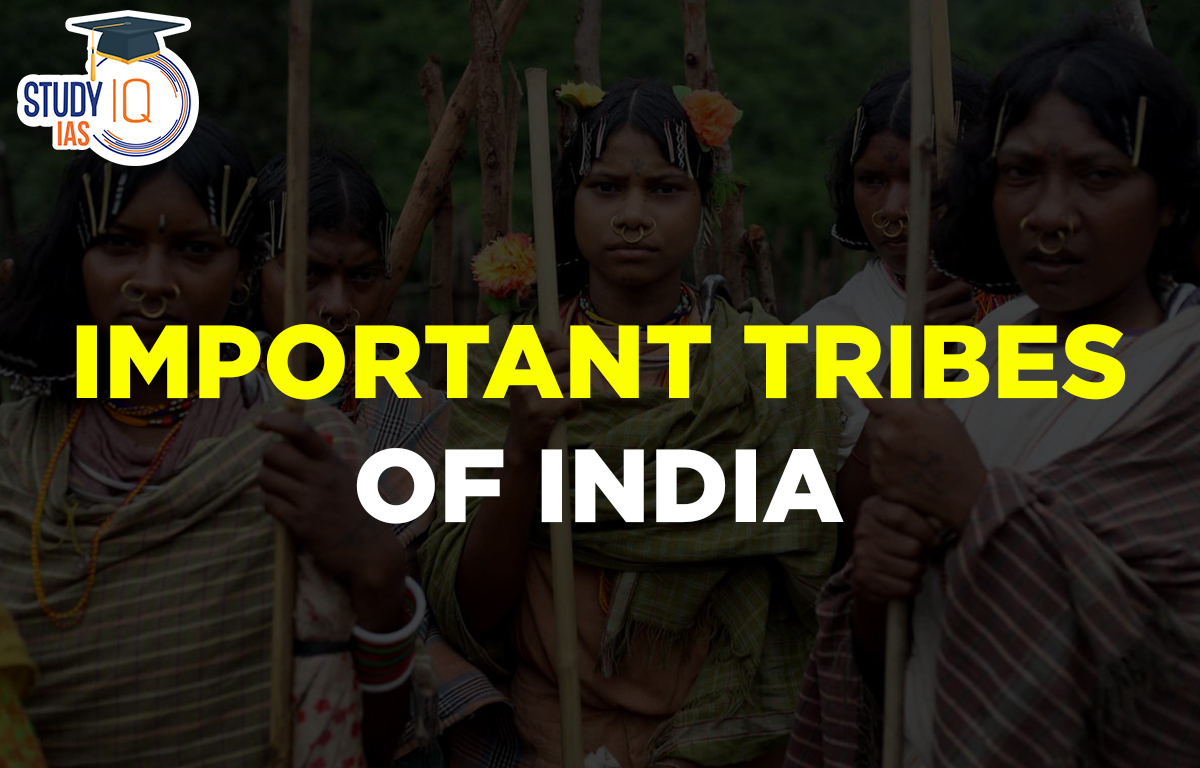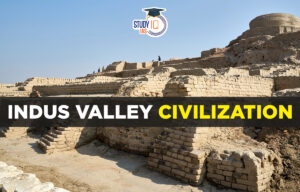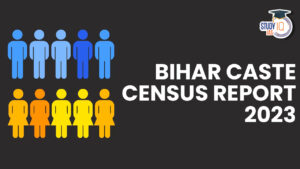Table of Contents
Tribes in India
Tribes in India: A tribe is a group of people who share common ancestors and cultures and prefer to live in a closed society. The tribes of India are the indigenous or native people who live all over the country. Tribes make up a sizable portion of the Indian population, and tribal culture is an important part of our intangible national heritage. As a result, we must learn about some of India’s most important tribes. Tribes are also referred to as ‘Adivasis’ in India.
What is a Tribe?
A tribe is a social division in a traditional society made up of families connected by social, economic, religious, or blood ties and sharing a common culture and dialect. A tribe has certain qualities and characteristics that distinguish it as a distinct cultural, social, and political entity.
Famous Tribes in India
According to the 2011 Census, the total population of Scheduled Tribes is 10.43 crore, accounting for 8.6% of the total population of the country. The Scheduled Tribe population in urban areas accounts for only 2.8% of the total. The states with the most Scheduled Tribes are Madhya Pradesh, Maharashtra, Orissa, Rajasthan, Gujarat, Jharkhand, Chhattisgarh, Andhra Pradesh, West Bengal, and Karnataka. These states account for 83.2% of the country’s total Scheduled Tribe population. Assam, Meghalaya, Nagaland, Jammu and Kashmir, Tripura, Mizoram, Bihar, Manipur, Arunachal Pradesh, and Tamil Nadu make up the remaining 15.3% of the Scheduled Tribe population.
The remaining states’ / UTs’ share is insignificant. Lakshadweep and Mizoram have the highest proportion of Scheduled Tribes in India, followed by Nagaland and Meghalaya. Madhya Pradesh has the most scheduled tribes, followed by Orissa. Chattisgarh’s Bastar district has the highest concentration of Scheduled Tribes. Punjab, Delhi, Chandigarh, Pondicherry, and Haryana have no Scheduled Tribes. Seats in the Lok Sabha are reserved for Scheduled Tribes. Census data is also considered in this case.
The allocation of seats for Scheduled Tribes in the Lok Sabha is based on the proportion of Scheduled Tribes in the State concerned to the total population, as provided for in Article 330 of the Indian Constitution read with Section 3 of the R. P. Act, 1950. In the Lok Sabha, 47 seats are reserved for Scheduled Tribes. The first schedule to the Representation of the People Act, 1950, as amended by the Representation of the People (Amendment) Act, 2008, provides the state-by-state breakdown.
Major Tribes in India State-wise List
Here are the Important Tribes of India 2023:
| States | Tribes |
| Andaman and Nicobar | Oraons, Onges, Sentinelese, Shompens |
| Andhra Pradesh | Andh, Sadhu Andh, Bhil, Bhagata, Chenchus (Chenchawar), Gadabas, Gond, Goundu, Jatapus, Kammara, Kattunayakan, Kolawar, Kolam, Konda, Manna Dhora, Pardhan, Rona, Savaras, Dabba Yerukula, Nakkala, Dhulia, Thoti, Sugalis, Banjara, Kondareddis, Koya, Mukha Dhora, Valmiki , Yenadis, Sugalis, Lambadis.
|
| Arunachal Pradesh | Apatanis, Abor, Dafla, Galong, Momba, Sherdukpen, Singpho, Nyishi, Mishmi, Idu, Taroan, Tagin, Adi, Monpa, Wancho
|
| Assam | Chakma, Chutiya, Dimasa, Hajong, Garos, Khasis, Gangte, Karbi, Boro, Borokachari, Kachari, Sonwal, Miri, Rabha, Garo.
|
| Bihar | Asur, Baiga, Birhor, Birjia, Chero, Gond, Parhaiya, Santhals, Savar, Kharwar, Banjara, Oraon, Santal, Tharu
|
| Jharkhand | Birhors, Bhumij, Gonds, Kharia, Mundas, Santhals, Savar, Bedia, Ho, Kharwar, Lohra, Mahli, Parhaiya, Santal, Kol, Banjara.
|
| Chhattisgarh | Agariya, Bhaina, Bhattra, Biar, Khond, Mawasi, Nagasia, Gond, Binjhwar, Halba, Halbi, Kawar, Sawar,
|
| Goa | Dhodia, Dubia, Naikda, Siddi,Varli, Gawda
|
| Gujarat | Barda, Bamcha, Bhil, Charan, Dhodia, Gamta, Paradhi, Patelia, Dhanka, Dubla, Talavia, Halpati, Kokna, Naikda, Patelia, Rathawa, Siddi.
|
| Himachal Pradesh | Gaddis, Gujjars, Khas, Lamba, Lahaulas, Pangwala, Swangla, Beta, Beda Bhot, Bodh.
|
| Jammu and Kashmir |
Bakarwal, Balti, Beda, Gaddi, Garra, Mon, Purigpa, Sippi, Changpa, Gujjar.
|
| Karnataka | Adiyan, Barda, Gond, Bhil, Iruliga, Koraga, Patelia, Yerava, Hasalaru, Koli Dhor, Marati , Meda, Naikda, Soligaru.
|
| Kerala | Adiyan, Arandan, Eravallan, Kurumbas, Malai arayan, Moplahs, Uralis, Irular, Kanikaran, Kattunayakan, Kurichchan, Muthuvan.
|
| Madhya Pradesh | Baigas, Bhils, Bharia, Birhors, Gonds, Katkari, kharia, Khond, Kol, Murias, Korku, Mawasi, Pardhan, Sahariya,
|
| Maharashtra | Bhaina, Bhunjia, Dhodia, Katkari, Khond, Rathawa, Warlis, Dhanka, Halba, Kathodi, Kokna, Koli Mahadev, Pardhi, Thakur,
|
| Madhya Pradesh | Baigas, Bhils, Bharia, Birhors, Gonds, Katkari, kharia, Khond, Kol, Murias, Korku, Mawasi, Pardhan, Sahariya,
|
| Maharashtra | Bhaina, Bhunjia, Dhodia, Katkari, Khond, Rathawa, Warlis, Dhanka, Halba, Kathodi, Kokna, Koli Mahadev, Pardhi, Thakur,
|
| Manipur | Naga, Kuki, Meitei, Aimol, Angami, Chiru, Maram, Monsang, Paite, Purum, Thadou, Anal, Mao, Tangkhul, Thadou, Poumai Naga.
|
| Meghalaya | Chakma, Garos, Hajong, Jaintias Khasis, Lakher, Pawai, Raba, Mikir.
|
| Mizoram | Chakma, Dimasa, Khasi, Kuki, Lakher, Pawi, Raba, Synteng, Lushai |
| Nagaland | Angami, Garo, Kachari, Kuki, Mikir, Nagas, Sema, Ao, Chakhesang, Konyak, Lotha |
| Odisha | Gadaba, Ghara, Kharia, Khond, Matya, Oraons, Rajuar, Santhals, Bathudi, Bathuri, Bhottada, Bhumij, Gond, Juang, Kisan, Kolha, Kora, Khayara, Koya, Munda, Paroja, Saora, Shabar, Lodha.
|
| Rajasthan | Bhils, Damaria, Dhanka, Meenas(Minas), Patelia, Sahariya, Naikda, Nayaka, Kathodi.
|
| Sikkim | Bhutia, Khas, Lepchas, Limboo, Tamang
|
| Tamil Nadu | Adiyan, Aranadan, Eravallan, Irular, Kadar, Kanikar, Kotas, Todas, Kurumans, Malayali,
|
| Telangana | Chenchus
|
| Tripura | Bhil, Bhutia, Chaimal, Chakma, Halam, Khasia, Lushai, Mizel, Namte, Mag, Munda, Riang,
|
| Uttarakhand | Bhotias, Buksa, Jannsari, Khas, Raji, Tharu.
|
| Uttar Pradesh | Bhotia, Buksa, Jaunsari, Kol, Raji, Tharu, Gond, Kharwar, Saharya , Parahiya, Baiga, Agariya, Chero
|
| West Bengal | Asur, Khond, Hajong, Ho, Parhaiya, Rabha, Santhals, Savar, Bhumij, Bhutia, Chik Baraik, Kisan, Kora, Lodha, Kheria, Khariam, Mahali, Mal Pahariya, Oraon,
|
Tribes in India Literacy
The overall literacy rate is an important indicator of a country’s development. As of 1961, the literacy rate among Indian tribes was as low as 8.5%. To improve the situation, the Government of India implemented numerous reservation schemes. Following the implementation of these broad-reaching policies, the literacy rate increased to 63.1% as of the 2011 census.
The census also discovered that male tribal members are 71% more literate than female tribal members, who have a literacy rate of around 54%. One of the primary reasons for this massive increase in figures is undoubtedly the government’s post-independence measures aimed at the upliftment of the tribal population. However, there are still some areas of complication and difficulty that significantly slow the rate of literacy progress among tribal people. Among these difficulties are:
- In terms of economic conditions, tribal people are typically very poor. As a result, parents usually prevent their children from attending school because they need more earners to run their families and survive.
- The tribal people live in remote and secluded areas with few or no transportation options. As a result, they are denied the light of education.
Many NGOs and groups are now stepping forward to work in this field. They are attempting to construct schools in remote tribal villages where children can not only study in their native languages but also stay and eat a square meal every day. They also assist tribal adults in earning a living by teaching them basic farming and handicraft skills. The Tribal Cooperative Marketing Development Federation of India (TRIFED) was founded in 1978 under the Multi-State Cooperative Societies Act of 1984 to work for the social and economic upliftment of the country’s tribal people.
Furthermore, tribal people play an important role in Indian culture. As a result, the government should do more to protect them and improve their living conditions by providing them with proper education.
Tribes in India FAQs
Q. How many tribes are there in India?
Ans. The Indian constitution recognises 645 distinct tribal communities in the country.
Q. Which is India’s most well-known and famous tribe?
Ans. The Bhils and Gonds are India’s most well-known tribes.
Q. What is the total population of tribals?
Ans. The tribal population of the country, as per the 2011 census, is 10.43 crore, constituting 8.6% of the total population.
Q. Which tribe is 2nd largest in India?
Ans. In terms of population, the Gond tribe is second only to the Bhils. The Gond tribe, India’s second-largest, is spread across states such as Andhra Pradesh, Telangana, Maharashtra, Bihar, and Orissa.
Q. Which is the smallest tribe in India?
Ans. Toto is a primitive Indo-Bhutanese tribe that lives in Totopara, a small enclave in the Jalpaiguri district of West Bengal, India.


 Indus Valley Civilization, History, Phas...
Indus Valley Civilization, History, Phas...
 Summer Solstice, Definition, Reason and ...
Summer Solstice, Definition, Reason and ...
 Bihar Caste Census Report 2023, Caste Wi...
Bihar Caste Census Report 2023, Caste Wi...





















